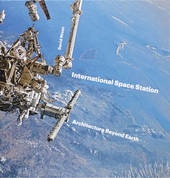
|
International Space Station: Architecture Beyond Earth
Hardback
Main Details
| Title |
International Space Station: Architecture Beyond Earth
|
| Authors and Contributors |
By (author) David Nixon
|
| Physical Properties |
| Format:Hardback | | Pages:416 | | Dimensions(mm): Height 235,Width 235 |
|
| Category/Genre | Theory of architecture
Architectural structure and design |
|---|
| ISBN/Barcode |
9780993072130
|
| Classifications | Dewey:629.442 |
|---|
| Audience | |
|---|
| Illustrations |
216 colour, 95 b&w
|
|
Publishing Details |
| Publisher |
Circa Press
|
| Imprint |
Circa Press
|
| Publication Date |
29 February 2016 |
| Publication Country |
United Kingdom
|
Description
"If you are a space fan, fascinated by the kind of venture the International Space Station represents, this book is an absolute must, full of juicy details and intriguing insights." - Popular Science, March 2016 In 1984 President Ronald Reagan gave NASA the go-ahead to build a Space Station. A generation later, the International Space Station is an established and highly successful research centre in Earth's orbit. The history of this extraordinary project is a complex weave of powerful threads - political, diplomatic, financial and technological among them - but none is more fascinating than the story of its design. This book provides the first comprehensive account of the International Space Station's conception, development and assembly in space. As a highly accessible chronicle of a complex piece of design and engineering, it will appeal to readers far beyond the space field. NASA Astronaut Nicole Stott, a veteran of International Space Station Expeditions 20 and 21 and Shuttle Missions STS-128, STS-129 and STS-133, introduces the book with a personal memoir: A Home in Space. AUTHOR: David Nixon is an architect with a particular interest in designing for space exploration. In 1978 he co-founded Future Systems with Jan Kaplicky and was among a handful of architects invited to work on the design of the International Space Station. He later established an office in Los Angeles to focus on work across the space field. In 2000 he formed Astrocourier to develop miniature spaceflight experiments for schools. This book is the result of seven years' research. SELLING POINTS: . A history of the International Space Station, through the lens of its architectural design . Foreword by NASA Astronaut Nicole Stott . Perfect for space enthusiasts, as well as anyone with an interest in challenging architectural problem solving 215 colour, 95 b/w
Author Biography
David Nixon is an architect with a particular interest in designing for space exploration. In 1978 he co-founded Future Systems with Jan Kaplicky and was among a handful of architects invited to work on the design of the International Space Station. He later established an office in Los Angeles to focus on work across the space field. In 2000 he formed Astrocourier to develop miniature spaceflight experiments for schools. This book is the result of seven years' research.
ReviewsI'm not aware of any book on the ISS that comes close to what Nixon offers here.--Inside Outer Space This book thoroughly chronicles the history, development, engineering, habitation, design, and, finally, "architecture" of the International Space Station. Weighing 422 tonnes, the ISS is still circling the planet every 90 minutes at about 17,500 miles per hour, coequal in the author's judgment to CERN's Large Hadron Collider in Switzerland. The book proceeds diligently from the 1960s to today, dividing American habitation in space into seven chapters. The ISS was constructed primarily by Russia and the United States after 1972, with contributions from Europe, Japan, Canada, Italy, and Brazil, and it still represents the most ambitious and the most complicated habitat ever conceived, contrived, and constructed by sapiens. This book culminates seven years of work by the author, embracing four valuable appendixes, more than 100 terms in the glossary, over 300 illustrations, 500-plus footnotes, and over 1,200 index terms in 400-plus pages. This heavy tome far replaces several smaller, outdated NASA paperbacks and reference guides with a much larger scope, a greater attention to detail, and a fully fashioned explanation of the complicated economics, politics, technologies, etc., of space exploration. This book definitely serves the general public. The author is a British architect who moved to California and has long specialized in the architecture and design of space exploration vehicles. Verdict Excellent for STEM education and lots of other disciplines.--Library Journal
|